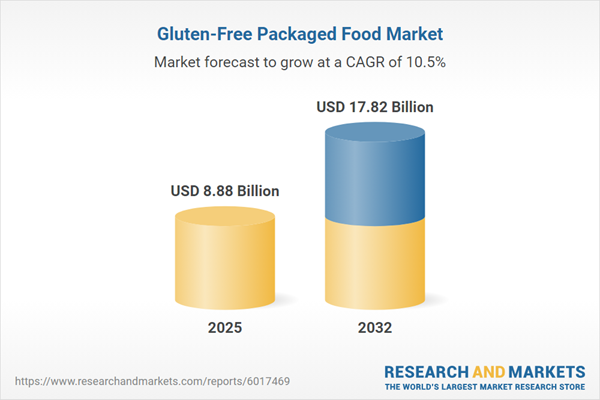Speak directly to the analyst to clarify any post sales queries you may have.
Senior leaders navigating the gluten-free packaged food sector are encountering rapid change as consumer health expectations and evolving regulatory frameworks reshape strategic priorities across sourcing, production, and distribution.
Market Snapshot: Gluten-Free Packaged Food Market Analysis
Between 2024 and 2025, the global gluten-free packaged food market will increase from USD 8.03 billion to USD 8.88 billion, representing a compound annual growth rate (CAGR) of 10.46%. Long-term projections indicate a total market value of USD 17.82 billion by 2032, highlighting robust momentum and persistent demand. The sector’s growth is powering innovation across product formats and supporting supply chain adaptation on regional and international scales.
Scope & Segmentation
- Product Types: Includes a wide array of packaged bakery products such as bread, cakes, pastries, cookies, and biscuits. Additional categories comprise functional and non-alcoholic beverages, frozen meal solutions, instant soups, sauces, ready-to-eat options, dairy alternatives, frozen desserts like ice cream and yogurt, and multiple varieties of gluten-free pasta and noodles. Segment diversity allows companies to address mainstream demand and align offerings for niche markets focused on health or convenience.
- Distribution Channels: Channels span convenience stores, drugstores, pharmacies, and an expanding set of online retail platforms. Direct brand e-commerce, established third-party players, specialty health outlets, supermarkets, and hypermarkets facilitate broad and targeted access, supporting both premium and mass market penetration strategies.
- End Users: The market serves groups including athletes, wellness and fitness professionals, individuals managing celiac disease, young consumers such as children and teenagers, and broader demographics seeking nutrition-oriented food alternatives. This diversity of end users drives continuous product and marketing adaptation to meet evolving expectations.
- Packaging Types: Packaging solutions encompass formats optimized for food service clients, household multi-packs, and retail single-serve packs. These developments address operational efficiency and convenience while enabling flexible distribution models.
- Regional Coverage: Geographical reach spans the Americas (United States, Canada, Mexico, Brazil, Argentina, Chile, Colombia, Peru), EMEA (including United Kingdom, Germany, France, Russia, Italy, Spain, and multiple Middle East and African markets), and Asia-Pacific (China, India, Japan, Australia, South Korea, Indonesia, Thailand, Malaysia, Singapore, Taiwan). Regional factors such as differing regulatory landscapes, diverse consumer habits, and emerging partnership structures shape localized growth prospects.
- Leading Companies Analyzed: Intelligence is provided on top players, including General Mills, Inc.; Conagra Brands, Inc.; B&G Foods, Inc.; Kellogg Company; Nestlé S.A.; Hain Celestial Group, Inc.; TreeHouse Foods, Inc.; Post Holdings, Inc.; The Kraft Heinz Company; and Campbell Soup Company, highlighting approaches to competition and expansion.
Key Takeaways for Senior Decision-Makers
- Heightened scrutiny of ingredients and supply chain transparency prompts brands to enhance traceability, ensure cleaner labeling, and reformulate to satisfy evolving stakeholder requirements.
- Functional and nutritional considerations are leading product innovation, enhancing differentiation as well as supporting growth in health-focused portfolios.
- Digital and direct-to-consumer business models are unlocking new value, enabling brands to deliver subscription models, tailored product suggestions, and sustained customer loyalty.
- Regional production reinforcement, thorough regulatory compliance, and investment in educational consumer resources underpin brands’ ability to build trust and expand in local markets.
- Formation of strategic alliances and acquisition-driven growth facilitates entry into specialty market segments and accelerates expansion opportunities.
- Packaging optimization increasingly addresses requirements for both retail and service clients, emphasizing sustainability, functional convenience, and seamless operational performance.
Tariff Impact: US Policy and Supply Chain Realignment
Recent US tariff updates regarding essential raw materials are raising procurement costs and pushing manufacturers to reexamine sourcing strategies. Companies are exploring relationships with suppliers offering tariff exemption or locality advantages, while prioritizing robust quality assurance. Advanced inventory management, supported by predictive analytics, enables agile response to supply variability. Transparent pricing and focused brand messaging further equip companies to manage challenging conditions and safeguard competitiveness in gluten-free packaged food supply chains.
Methodology & Data Sources
This research leverages direct engagements with key industry stakeholders—including suppliers, manufacturers, and retail executives—supplemented by regulatory documentation and leading industry reports. Analytical frameworks such as Porter’s Five Forces, comprehensive value chain mapping, and consumer journey studies underpin the report’s actionable intelligence.
Why This Report Matters
- Supports executive decision-making with evidence-based guidance for launching products, selecting optimal market entry windows, and building resilient gluten-free packaged food supply chains.
- Offers actionable perspectives on consumer demand shifts, evolving distribution routes, and regulatory developments, informing risk mitigation and future growth strategies.
- Guides leaders on effective partnership selection, investment opportunities, and forward-thinking go-to-market planning in the context of industry-wide technological and operational change.
Conclusion
Strategic flexibility and collaboration remain crucial as sector stakeholders address rapid change in the gluten-free packaged food landscape. This analysis equips senior decision-makers to anticipate shifting market dynamics and strengthen resilience for continued growth.
Additional Product Information:
- Purchase of this report includes 1 year online access with quarterly updates.
- This report can be updated on request. Please contact our Customer Experience team using the Ask a Question widget on our website.
Table of Contents
3. Executive Summary
4. Market Overview
7. Cumulative Impact of Artificial Intelligence 2025
Companies Mentioned
The companies profiled in this Gluten-Free Packaged Food market report include:- General Mills, Inc.
- Conagra Brands, Inc.
- B&G Foods, Inc.
- Kellogg Company
- Nestlé S.A.
- Hain Celestial Group, Inc.
- TreeHouse Foods, Inc.
- Post Holdings, Inc.
- The Kraft Heinz Company
- Campbell Soup Company
Table Information
| Report Attribute | Details |
|---|---|
| No. of Pages | 198 |
| Published | October 2025 |
| Forecast Period | 2025 - 2032 |
| Estimated Market Value ( USD | $ 8.88 Billion |
| Forecasted Market Value ( USD | $ 17.82 Billion |
| Compound Annual Growth Rate | 10.4% |
| Regions Covered | Global |
| No. of Companies Mentioned | 11 |









